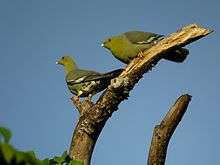Madagascan green pigeon
The Madagascan green pigeon (Treron australis) is a species of bird in the family Columbidae. It is found in Madagascar, Comoros, and Mayotte. The taxon griveaudi, by most authorities considered a subspecies of the Madagascan green pigeon, is sometimes considered a separate species, the Comoros green pigeon (Treron comorensis). Its natural habitats are subtropical or tropical dry forest and subtropical or tropical moist lowland forest.
| Madagascan green pigeon | |
|---|---|
 | |
| At Ankarafantsika National Park, Mahajanga Province, Madagascar | |
| Scientific classification | |
| Kingdom: | Animalia |
| Phylum: | Chordata |
| Class: | Aves |
| Order: | Columbiformes |
| Family: | Columbidae |
| Genus: | Treron |
| Species: | T. australis |
| Binomial name | |
| Treron australis (Linnaeus, 1771) | |

Taxonomy
In 1760 the French zoologist Mathurin Jacques Brisson included a description of the Madagascan green pigeon in his Ornithologie based on specimen that he had examined. He used the French name Le pigeon ramier verd de Madagascar and the Latin Palumbus viridis madagascariensis.[2] The species was also illustrated in Edme-Louis Daubenton's Planches Enluminées D'Histoire Naturelle.[3] Although Brisson coined Latin names, these do not conform to the binomial system and are not recognised by the International Commission on Zoological Nomenclature.[4] When the Swedish naturalist Carl Linnaeus revised his Mantissa Plantarum in 1771 he added an appendix which included a description of the Madagascan green pigeon. He coined the binomial name Columba australis and cited the earlier authors.[5] The specific epithet australis is the Latin word for "southern".[6] The species is now placed in the genus Treron that was introduced in 1816 by the French ornithologist Louis Jean Pierre Vieillot.[7][8]
Two subspecies are recognised:[8]
- T. a. xenius Salomonsen, 1934 – west Madagascar
- T. a. australis (Linnaeus, 1771) – east Madagascar
References
- BirdLife International 2016. Treron australis. The IUCN Red List of Threatened Species 2016: e.T22727848A94963482. https://doi.org/10.2305/IUCN.UK.2016-3.RLTS.T22727848A94963482.en. Downloaded on 19 August 2019.
- Brisson, Mathurin Jacques (1760). Ornithologie, ou, Méthode contenant la division des oiseaux en ordres, sections, genres, especes & leurs variétés (in French and Latin). Volume 1. Paris: Jean-Baptiste Bauche. pp. 142–143, Plate 14 fig 2. The two stars (**) at the start of the section indicates that Brisson based his description on the examination of a specimen.
- Buffon, Georges-Louis Leclerc de; Martinet, François-Nicolas; Daubenton, Edme-Louis; Daubenton, Louis-Jean-Marie (1765–1783). "Pigeon ramier verd, de Madagascar". Planches Enluminées D'Histoire Naturelle. Volume 2. Paris: De L'Imprimerie Royale. Plate 111.
- Allen, J.A. (1910). "Collation of Brisson's genera of birds with those of Linnaeus". Bulletin of the American Museum of Natural History. 28: 317–335.
- Linnaeus, Carl (1771). "Regni Animalis Appendix. Aves". Mantissa Plantarum Altera (in Latin). Holmiae [Stockholm]: Laurentius Salvii. p. 526.
- Jobling, James A. (2010). The Helm Dictionary of Scientific Bird Names. London: Christopher Helm. p. 62. ISBN 978-1-4081-2501-4.
- Vieillot, Louis Jean Pierre (1816). Analyse d'une Nouvelle Ornithologie Elementaire (in French). Paris: Deterville/self. p. 49.
- Gill, Frank; Donsker, David; Rasmussen, Pamela, eds. (2020). "Pigeons". IOC World Bird List Version 10.1. International Ornithologists' Union. Retrieved 23 March 2020.
